Even if you’ve never made homemade bread or worked with yeast before, this homemade crusty artisan bread is for you. It’s the perfect beginner recipe because it only requires 4 ingredients without any special pans or mixer, there’s no kneading or complicated shaping involved, and 95% of the work is hands-off. Bread masters will appreciate this recipe too because it delivers with delicious flavor, a slightly crisp and mega chewy crust, and those signature soft holes inside like ciabatta or French bread.
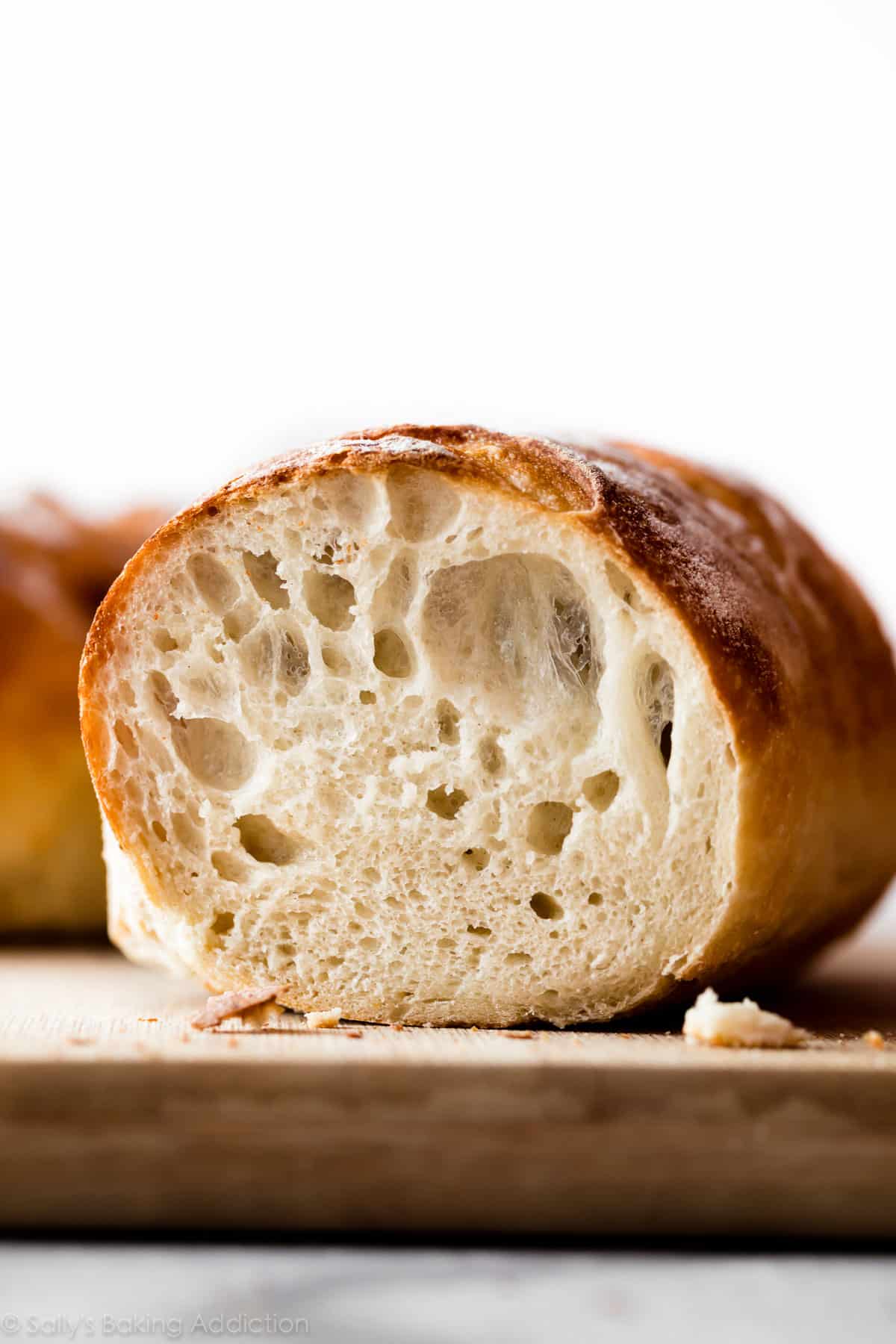
Bread Beginners—Start Here
Have you ever wanted to master homemade bread? Real, crusty, chewy, delicious bakery-style loaves that taste incredible with dips, soups, sauces, and comforting dinners? This recipe is where you start. This artisan bread is for beginners, but even bread masters will appreciate its flavor and ease. It’s so fresh, so flavorful, and so surprisingly easy because it basically makes itself.
You only need 4 ingredients without any special pans or mixer, there’s no kneading, no poolish or dough starter required, and you can add herbs, cheeses, and spices to make a variety of bread flavors.
This base recipe will soon be on repeat in your kitchen. After you realize how easy it is to make real homemade bread, you’ll find any excuse to bake a loaf.
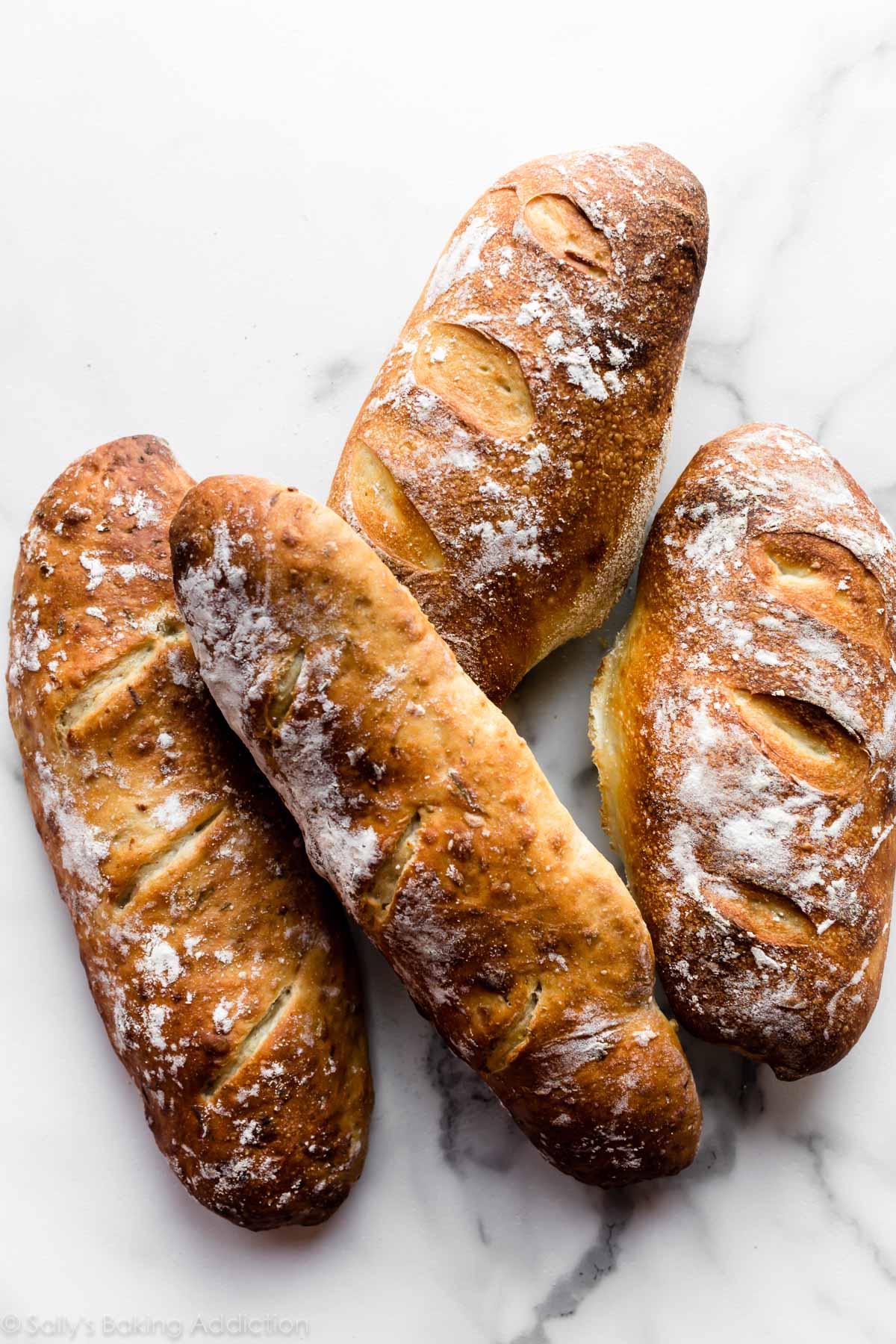
What is Homemade Artisan Bread?
When it comes to bread, the term “artisan” doesn’t mean 1 particular thing. But generally, artisan bread is homemade, fresh, crusty, and deliciously rustic looking. An artisan is a skilled worker, one who works with their hands. But ironically, there isn’t much “work” involved with this recipe.
Why You’ll Love This Bread
- Easier than you ever imagined
- Soft + flavorful
- Chewy, slightly crisp crust
- Shape however you want
- No special pans, poolish, or dough starter required
- Only 4 ingredients
- You decide the length of time it rests
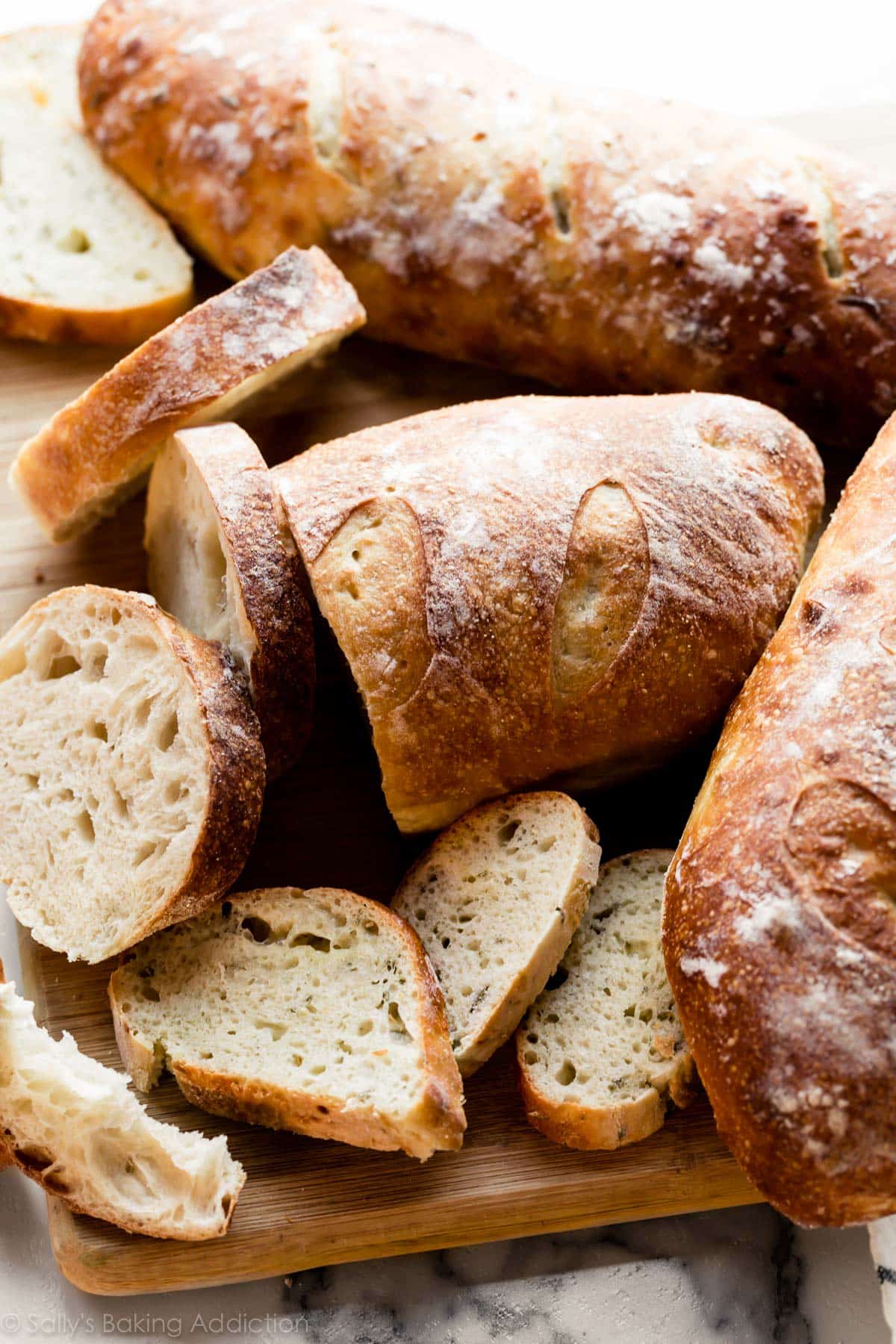
Homemade Artisan Bread Video Tutorial
Like sandwich bread, whole wheat bread, focaccia, homemade English muffins, seeded oat bread, and homemade bagels—the process is surprisingly easy. If you’re new to yeast, reference my Baking with Yeast Guide for answers to common yeast FAQs.
Only 4 Ingredients
The crustier and chewier the bread, the less fat in the dough—also known as a “lean dough.” We’re using a lean dough for our artisan loaf today. (If you’re curious, a “rich dough” is a soft bread dough with the presence of fat, such as butter and eggs—the kind we need for overnight cinnamon rolls and honey butter rolls.) Without fat, we’re left with the basics.
- Bread Flour: While you can use all-purpose flour in this recipe, I strongly recommend using bread flour. Just like when we make olive bread, bread flour produces a stronger, chewier bread and that makes a big difference in recipe with only 3 other ingredients.
- Instant Yeast: Instant yeast is key in this recipe. While you can use active dry if that’s all you have, any quick rise or instant yeast will produce flavorful results in less time. I use more yeast in this recipe compared to my cranberry nut no-knead bread and no-knead jalapeño cheddar bread. Why? Those doughs rest and rise at room temperature. However, for more flavor and just as much rise, I use more yeast and let the this dough rest in the refrigerator. (Cool air slows the fermentation process.)
- Salt: You can’t make good bread without salt and for best flavor, I recommend a coarse salt, such as coarse sea salt. I find the bread’s flavor lacking with regular table salt.
- Water: I normally encourage you to use warm liquid with yeast because warm liquid helps the yeast work faster. However, use cool or room temperature water here. Not freezing cold, not super warm—cool to touch. 70°F (21°C) is great, but the exact temperature doesn’t matter as long as it’s not hot or warm. The cooler the water, the longer the dough takes to rise and, usually, the better the bread’s flavor. (This is important since there are so little ingredients to add substantial flavor!) We use the same cool water method for no knead honey oat bread.
- Optional Cornmeal: Dusting the pan with cornmeal adds a pop of flavor and a little crunch to the bottom crust. This is completely optional. If you have it, use it. If you don’t have it, don’t worry about it.
You can also add herbs and seasonings such as garlic, rosemary, dill, chopped onion, jalapeño, shredded cheese, chopped nuts, dried cranberries, etc. My no yeast bread is the quick bread alternative here—you can add flavors to that loaf, too!
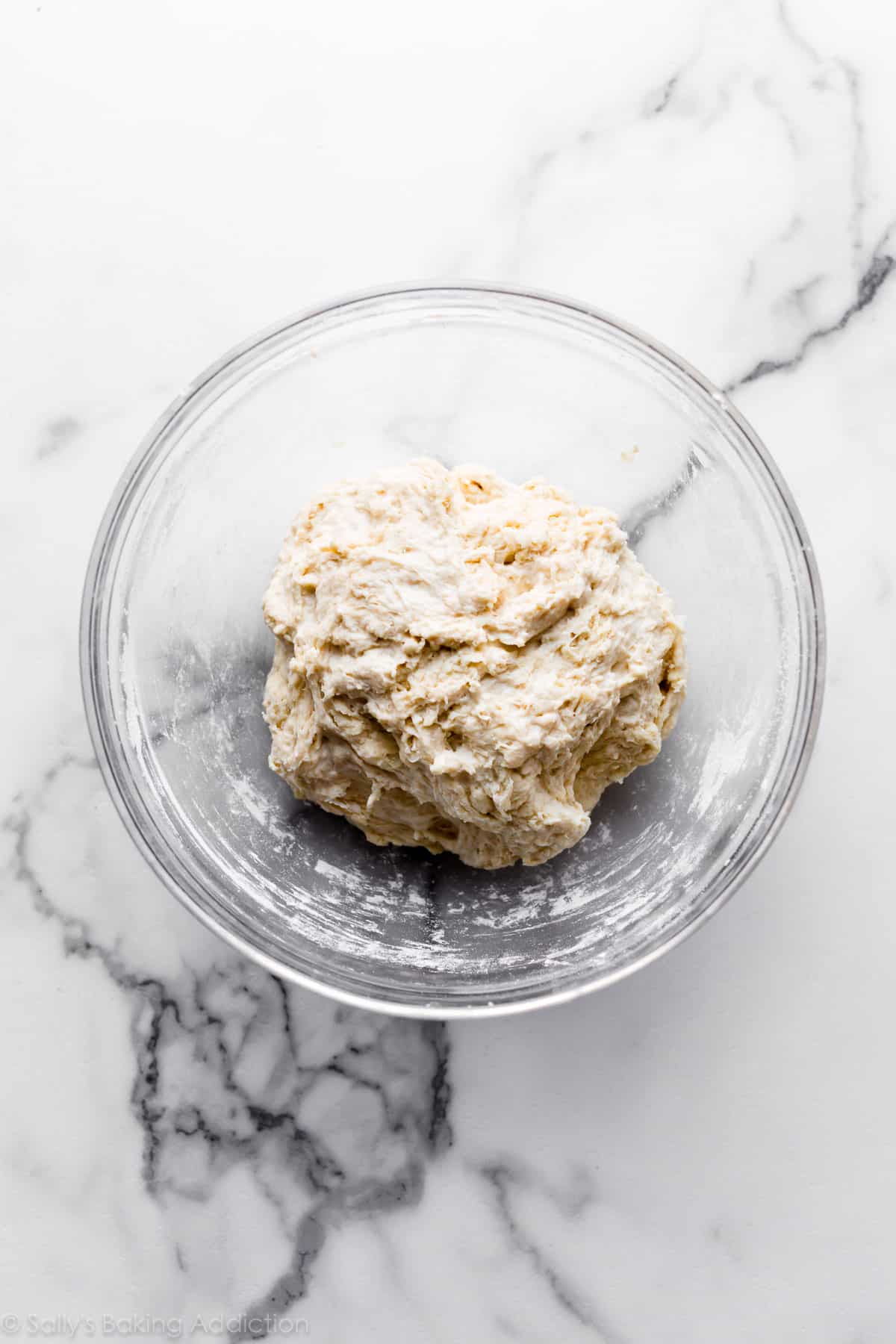
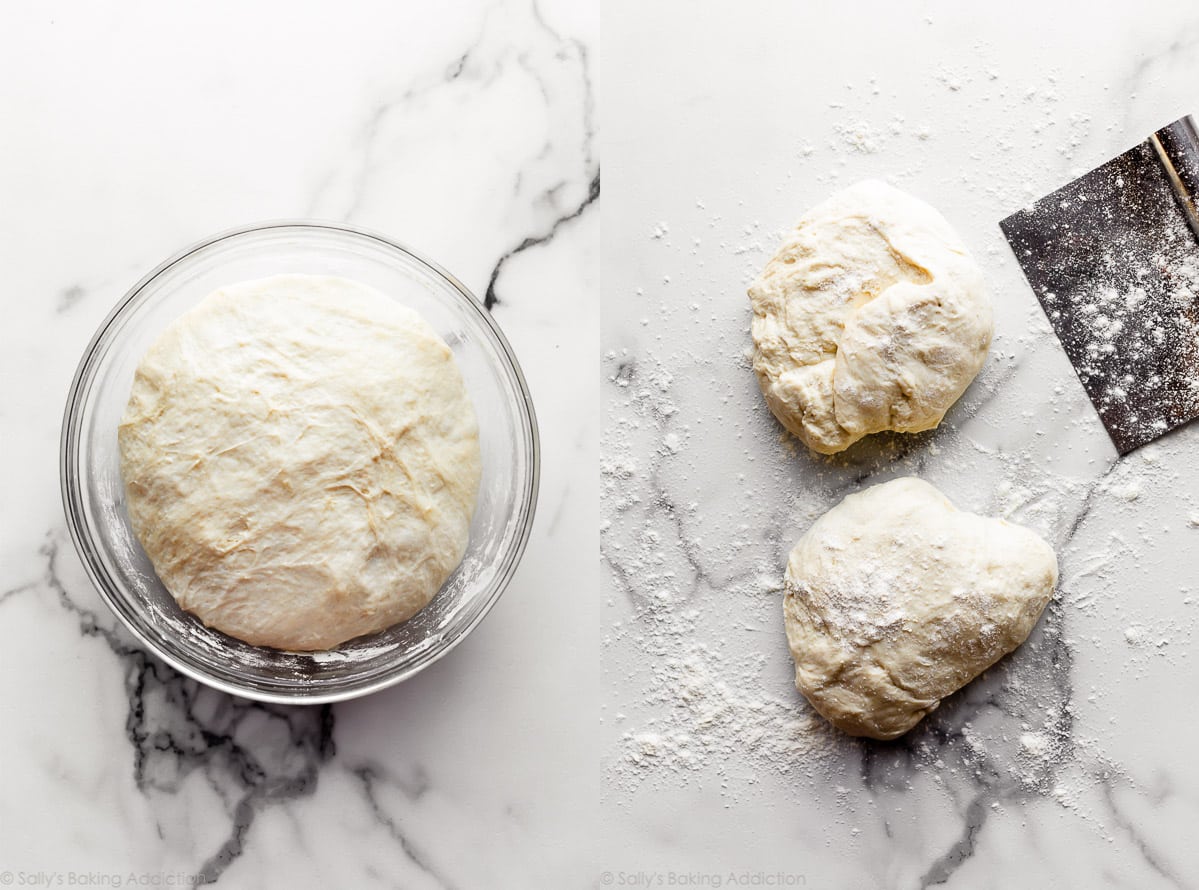
Baker’s Tip: Avoid adding too much flour to the dough as you work with it. The stickier it is—and the longer it sits in the refrigerator—the more likely you’ll have those big airy pockets of air in the crumb.
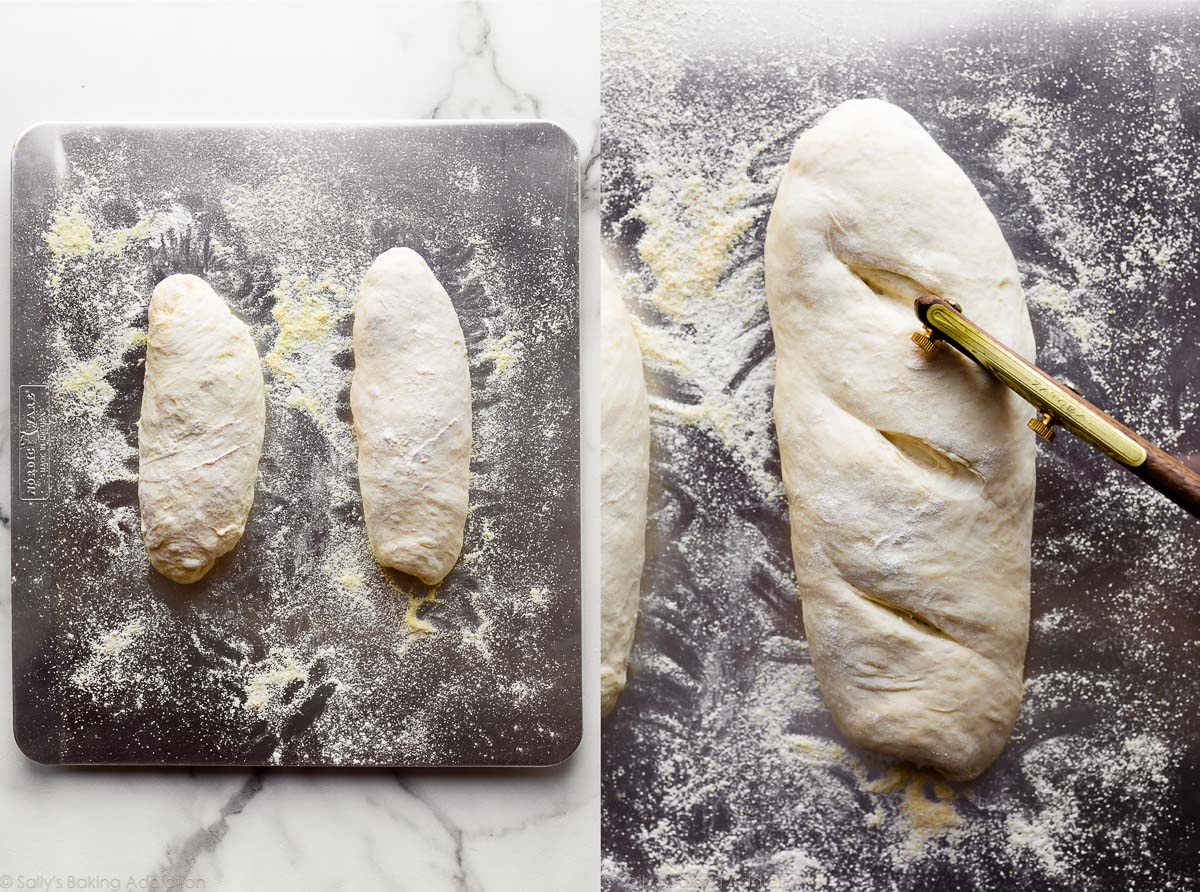
How to Make Homemade Artisan Bread in 5 Steps
- Mix the dough ingredients together. At first the dough will seem very dry and shaggy and you’ll question if it will even come together. But it will. Use a spatula at first, then switch to your hands to ensure all of the flour is moistened. The dough is actually a little sticky after it’s thoroughly mixed.
- Let it rise at room temperature for 2-3 hours. Cover the dough and let it rise at room temperature for about 2-3 hours until doubled in size.
- Use right away or refrigerate. After 2-3 hours, you can immediately continue with the next step. However, for ideal flavor and texture, I strongly recommend letting the dough sit in the refrigerator for at least 12 hours and up to 3 days. Yes, 3 full days! I usually only let it rest for about 18 hours. During this crucial step, the cold air slows the fermentation process and adds so much flavor and texture. So, you can bake bread in 2-3 hours or in 3 days. The longer it sits, the better it tastes. 🙂
- Shape into 2 loaves or 1 boule. Rest as oven preheats. You can shape the bread into a round loaf (boule) or two longer loaves. I usually make 2 longer loaves side-by-side on a flat baking sheet, about 9×3 inches each. Score with a sharp knife or bread lame. Preheat the oven to a very hot 475°F (246°C). The extremely hot air will immediately set the crust so the bread rises up instead of spreading all over. To help ensure a crispier crust, after the oven pre-heats—pour boiling water into a metal or cast iron baking pan/dish on the bottom oven rack. Immediately place the dough inside and shut the oven door to trap the steam. The steam will help create that coveted crisp crust. If you have a dutch oven, shape the dough into 1 round loaf, and bake it inside the dutch oven with the lid on.
- Bake until golden brown, about 20-25 minutes. Gently tap the loaves because if they sound hollow, they’re done.
Look at those deliciously soft holes inside! Reminds me of ciabatta or a French baguette, both of which can be a little more complicated to make.
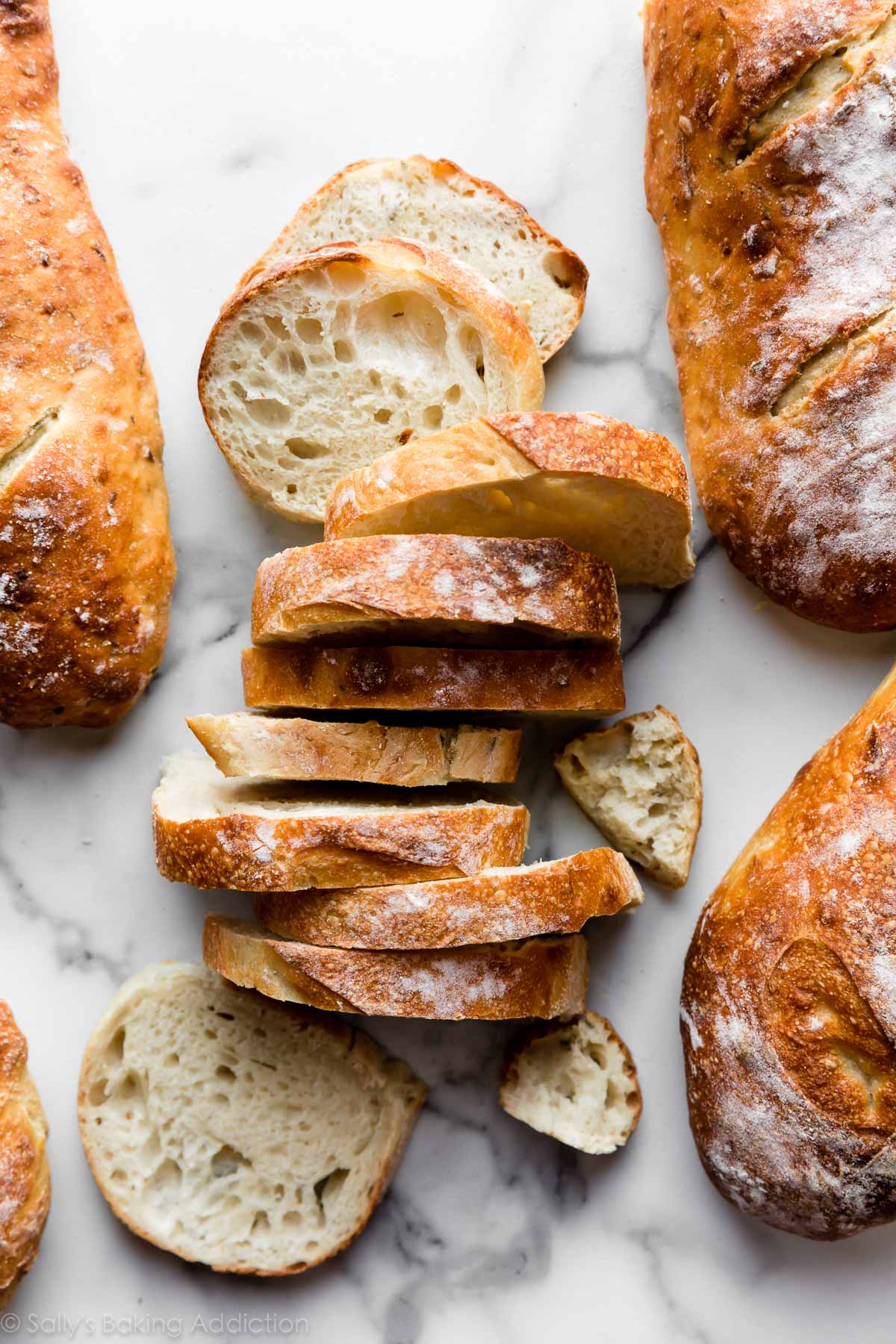
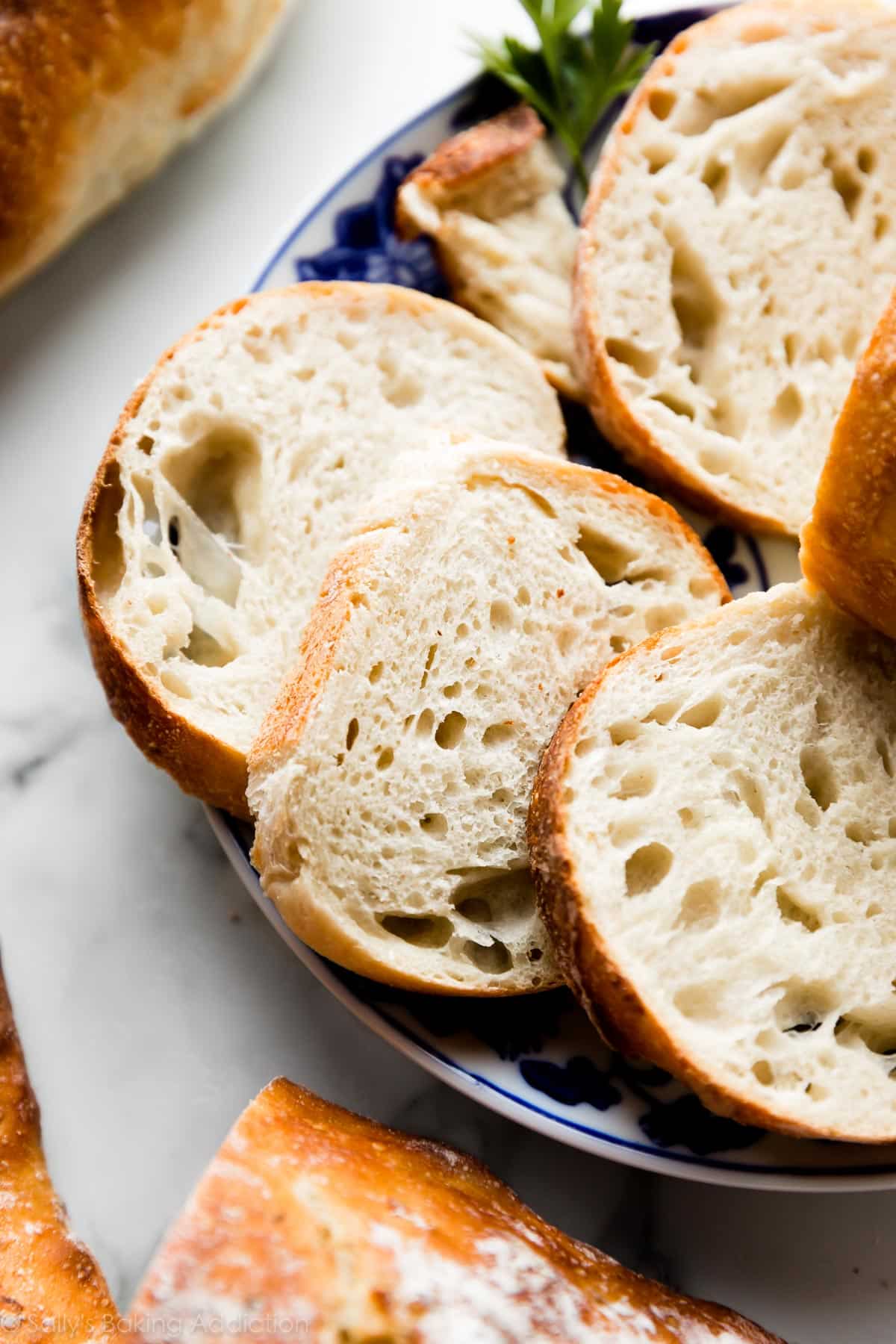
Serve Artisan Bread With
- Slather with homemade honey butter
- Slice and dunk in crab dip, beer cheese dip, or roasted garlic bacon spinach dip
- Serve alongside slow cooker chicken chili or pumpkin chili
- As a dunker for minestrone soup or creamy chicken noodle soup
- With a big bowl of mac & cheese
- Use for my goat cheese & honey crostini
- It’s the perfect starch in breakfast casserole
- With anything because homemade bread is everything’s best friend
See Your Homemade Artisan Bread!
Many readers tried this recipe as part of a baking challenge! Feel free to email or share your recipe photos with us on social media. 🙂
Print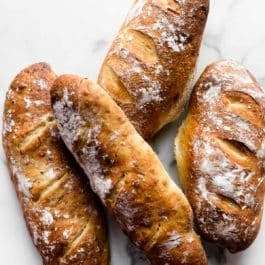
Homemade Artisan Bread Recipe
- Prep Time: 4 hours
- Cook Time: 25 minutes
- Total Time: 4 hours, 25 minutes
- Yield: 2 8-inch loaves
- Category: Bread
- Method: Baking
- Cuisine: American
Description
Even if you’ve never made homemade bread or worked with yeast before, this homemade artisan bread is for you. Watch the video tutorial below and review the recipe instructions and recipe notes prior to beginning. If you’re new to working with yeast, reference my Baking with Yeast Guide for answers to common yeast FAQs.
Ingredients
- 3 and 1/4 cups (about 430g) bread flour (spooned & leveled), plus more for hands and pan
- 2 teaspoons (about 6g) instant yeast
- 2 teaspoons (about 9g) coarse salt (see note)
- 1 and 1/2 cups (360ml) water, close to room temperature at about 70°F (21°C)
- optional: cornmeal for dusting pan
Instructions
- In a large un-greased mixing bowl, whisk the flour, yeast, and salt together. Pour in the water and gently mix together with a silicone spatula or wooden spoon. The dough will seem dry and shaggy, but keep working it until all the flour is moistened. If needed, use your hands (as I do in the video tutorial below) to work the dough ingredients together. The dough will be sticky. Shape into a ball in the bowl as best you can.
- Keeping the dough in the bowl, cover the dough tightly with plastic wrap or aluminum foil and set on the counter at room temperature (honestly any normal room temperature is fine!). Allow to rise for 2-3 hours. The dough will just about double in size, stick to the sides of the bowl, and have a lot of air bubbles.
- You can continue with step 4 immediately, but for absolute best flavor and texture, I strongly recommend letting this risen dough rest in the refrigerator for at least 12 hours and up to 3 days. Place covered dough in the refrigerator for 12 hours – 3 days. I usually let it rest in the refrigerator for about 18 hours. The dough will puff up during this time, but may begin to deflate after 2 days. That’s fine and normal—nothing to worry about.
- Lightly dust a large nonstick baking sheet (with or without rims and make sure it’s nonstick) with flour and/or cornmeal. Turn the cold dough out onto a floured work surface. Using a sharp knife or bench scraper, cut dough in half. Some air bubbles will deflate as you work with it. Place dough halves on prepared baking sheet. Using floured hands, shape into 2 long loaves about 9×3 inches each (doesn’t have to be exact) about 3 inches apart. Loosely cover and allow to rest for 45 minutes. You will bake the dough on this prepared baking sheet.
- During this 45 minutes, preheat the oven to 475°F (246°C).
- When ready to bake, using a very sharp knife or bread lame (some even use kitchen shears), score the bread loaves with 3 slashes, about 1/2 inch deep. (“Score” = shallow cut.) If the shaped loaves flattened out during the 45 minutes, use floured hands to narrow them out along the sides again.
- Optional for a slightly crispier crust: After the oven is preheated and bread is scored, place a shallow metal or cast iron baking pan or skillet (I usually use a metal 9×13-inch baking pan) on the bottom oven rack. Carefully and quickly pour 3-4 cups of boiling water into it. Place the scored dough/baking pan on a higher rack and quickly shut the oven, trapping the steam inside. The steam helps create a crispier crust.
- Place the shaped and scored dough (on the flour/cornmeal dusted pan) in the preheated oven on the center rack. Bake for 20-25 minutes or until the crust is golden brown. Gently tap the loaves—if they sound hollow, the bread is done. For a more accurate test of doneness, the bread is done when an instant read thermometer inserted in the center reads 195°F (90°C).
- Remove the bread from the oven and allow to cool for at least 5 minutes before slicing and serving. Store leftovers loosely covered at room temperature for up to 5 days or in the refrigerator for up to 10 days.
Notes
- Make Ahead & Freezing Instructions: The dough can sit in the refrigerator for up to 3 days, so this is a wonderful recipe to begin ahead of time. You can also bake the bread, allow it to cool, and freeze for up to 3 months. Thaw in the refrigerator and allow to come to room temperature before serving. You can also freeze the dough. Complete the recipe through step 3. Wrap in plastic wrap and place in a freezer-friendly container. To bake, allow dough to thaw overnight in the refrigerator, or for 2-3 hours at room temperature. Continue with step 4 and the rest of the recipe instructions.
- Special Tools (affiliate links): Glass Mixing Bowls | Silicone Spatula or Wooden Spoon | Baking Sheets | 2-cup Measuring Cup | Bread Lame | Instant Read Thermometer
- Flour: For absolute best flavor and chewy texture, I strongly recommend using bread flour. You can use a 1:1 substitution of all-purpose flour in a pinch with no other changes to the recipe. I recommend avoiding whole wheat flour in this dough. If necessary, use half bread flour and half whole wheat flour. The bread will taste a bit dense.
- Yeast: You can use instant or active dry yeast, but I highly recommend an instant (aka “rapid rise” or “quick rise” yeast). The bread will rise faster. I usually use Platinum yeast by Red Star, which is an instant yeast. 2 teaspoons is a little less than 1 standard packet. If using active dry yeast, there are no changes needed to the recipe. The rise time in step 2 may take longer.
- Salt: Use a coarse salt, such as coarse sea salt, in this bread. I find the flavor slightly lacking when using regular table fine salt. If you only have fine salt, reduce to 1 and 1/2 teaspoons.
- Water: Use cool water. 70°F (21°C) is great, but the exact temperature doesn’t matter as long as it’s not hot or warm.
- Round Loaf: If you want to shape the dough into a boule (round loaf) simply shape into a round ball instead of 2 loaves in step 4. Baking instructions are the same, but the loaf will take a few extra minutes in the oven. If you want to bake the boule in a dutch oven, see next note.
- Using a Dutch Oven: Follow this dough recipe through step 3, then follow the simple shaping/baking instructions (steps 2-5) in my Cranberry Nut No Knead Bread recipe including using the parchment paper. If your parchment paper can’t withstand heat this high, you can either lower the oven temperature and bake the bread for longer or grease the Dutch oven instead.
- Using a pizza stone: If you want to bake your bread loaves on a pizza stone, place pizza stone in the preheating oven. In step 8, place the shaped and scored dough on your preheated pizza stone. If the bottom of the shaped dough is pretty sticky, dust the hot pizza stone with some extra cornmeal. Bake as directed.
- No Nonstick Pan: If you don’t have a nonstick baking sheet, line it with parchment paper instead. Coat with a dusting of flour and/or cornmeal before placing the dough on top. Parchment paper can burn, so it’s best to check the box to see how much heat yours can tolerate. Lower your oven heat if necessary and bake the bread for longer until golden brown and when gently tapped, sound hollow.
- Flavor ideas: Before pouring in the water in step 1, add any of the following ingredients/combination of ingredients to the dry ingredients in the bowl: 4 cloves minced garlic + 3 Tablespoons chopped rosemary, 3 Tablespoons your favorite fresh herb (chopped), 1 cup your favorite shredded cheese, a diced jalapeño, 3/4 – 1 cup dried cranberries and/or chopped nuts, 2 teaspoons garlic powder, etc.
- Reference my Baking with Yeast Guide for answers to common yeast FAQs.
- Recipe adapted from King Arthur Flour & Red Star Yeast, similar method originally from Jim Lahey.
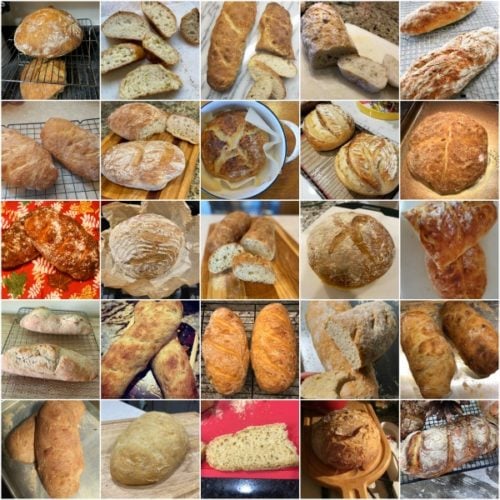
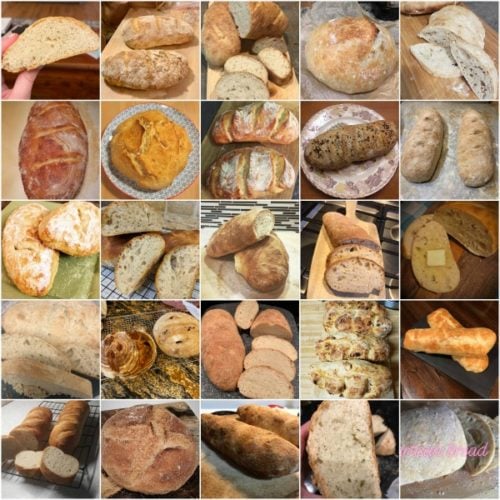
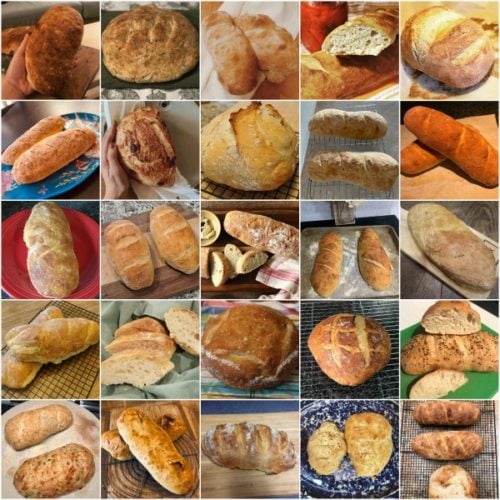
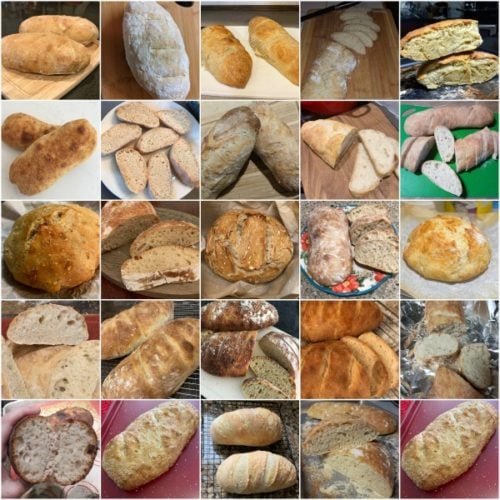
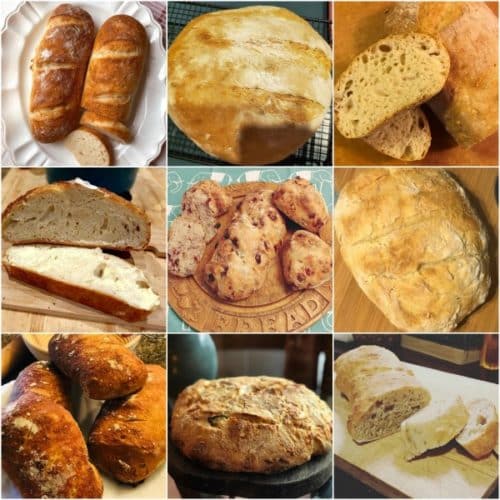
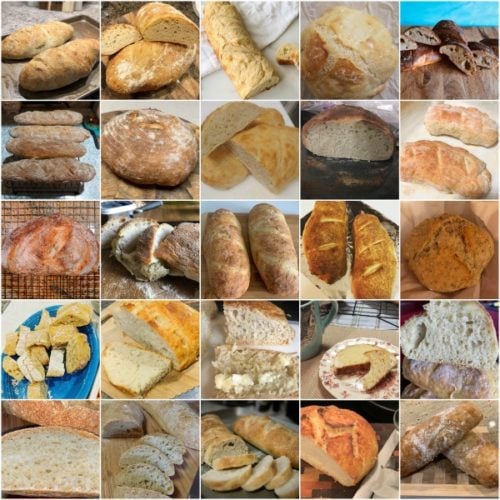
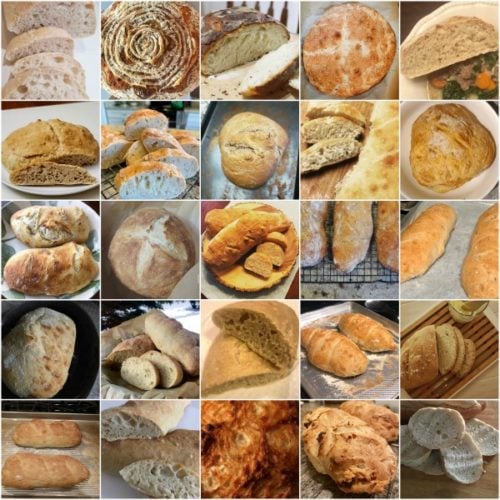
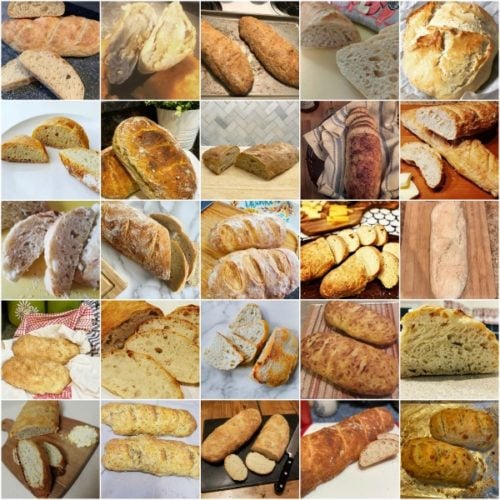
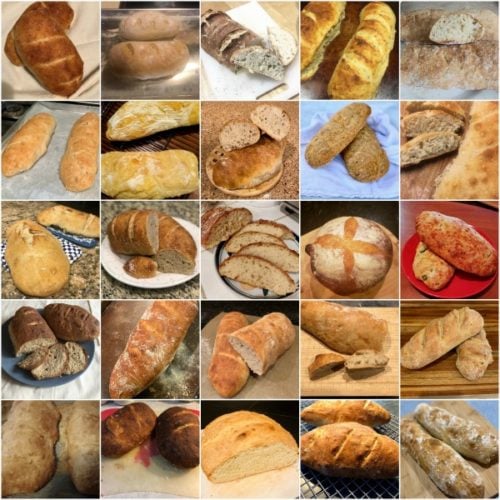
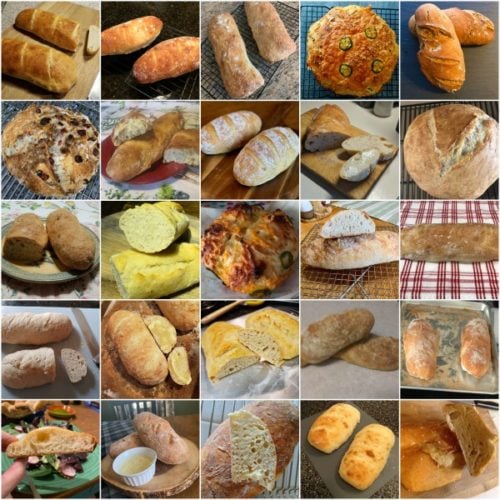
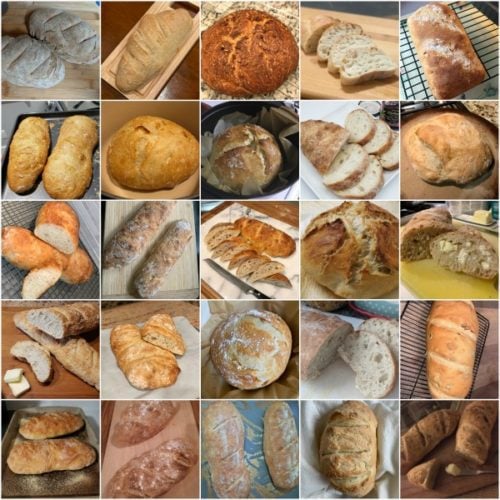
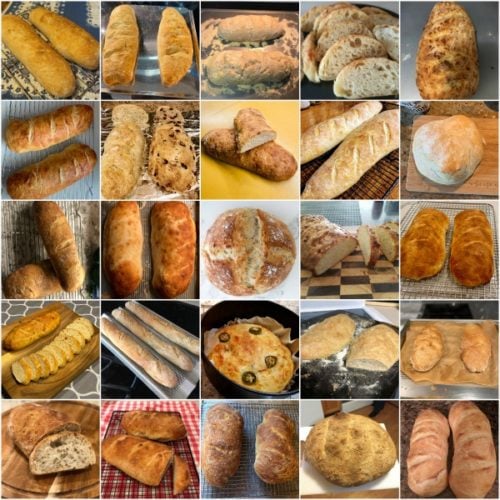
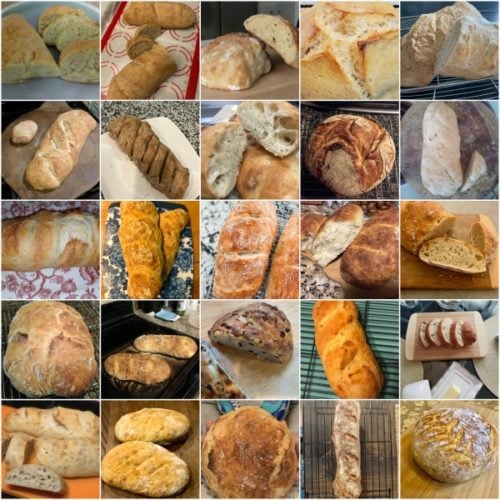
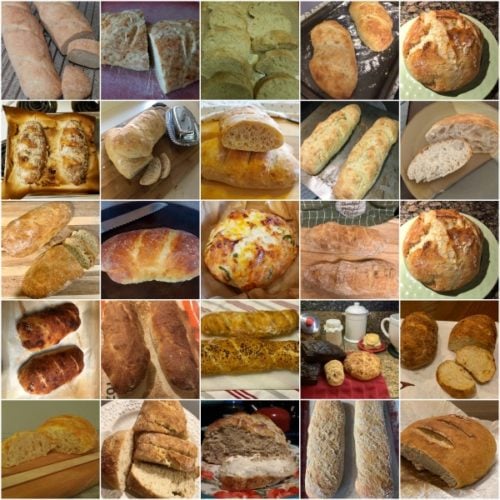
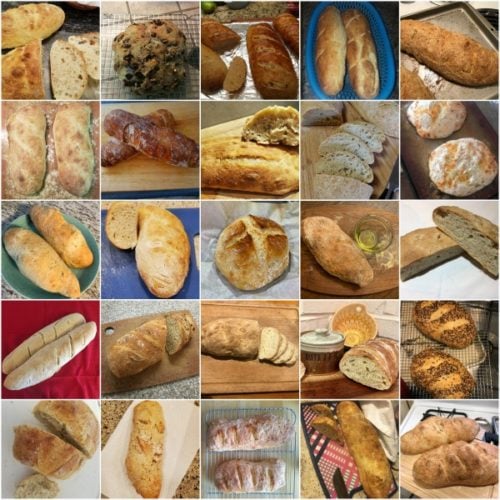
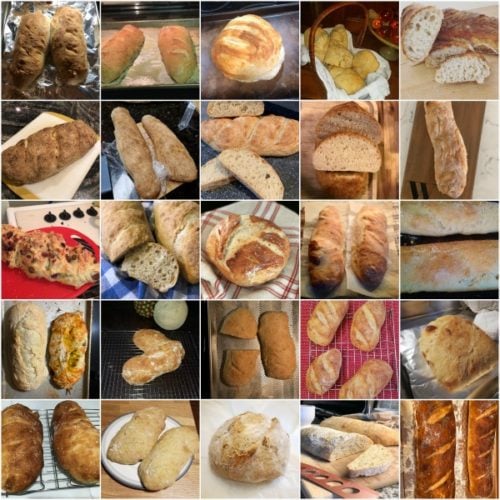

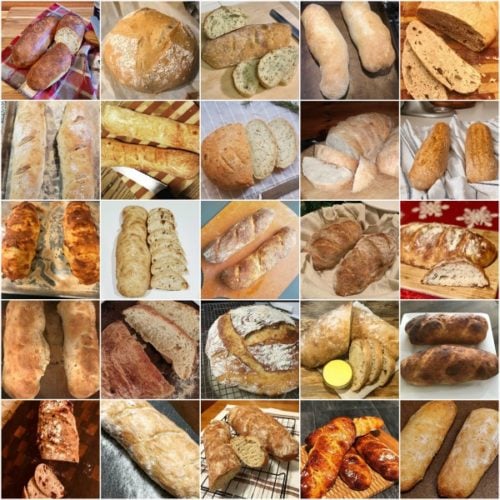
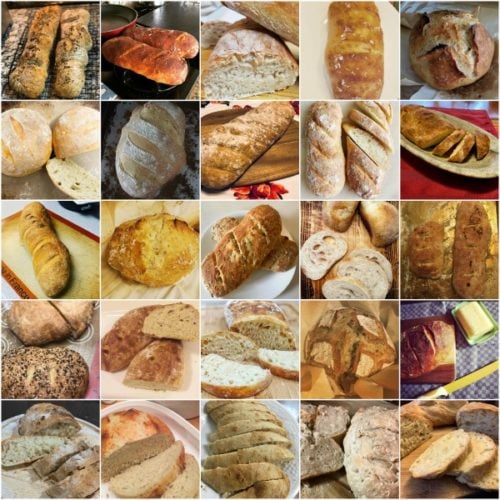
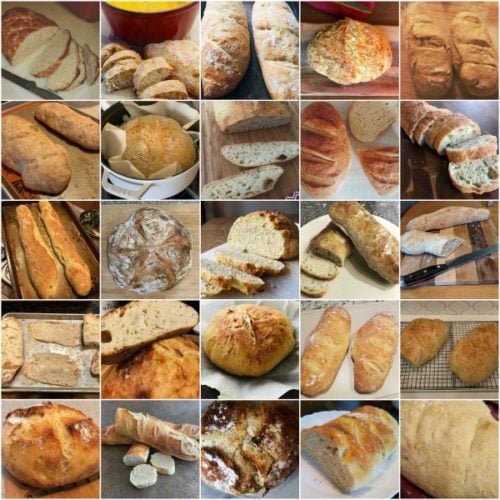
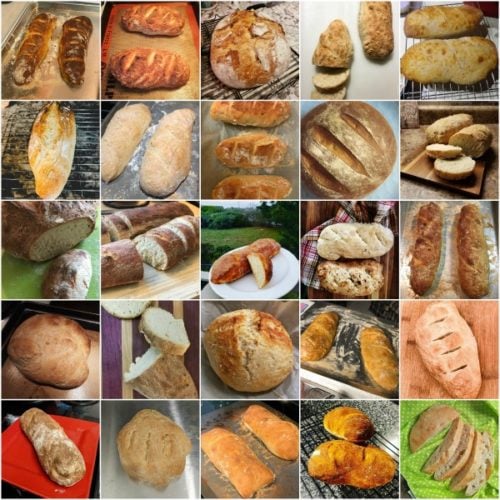
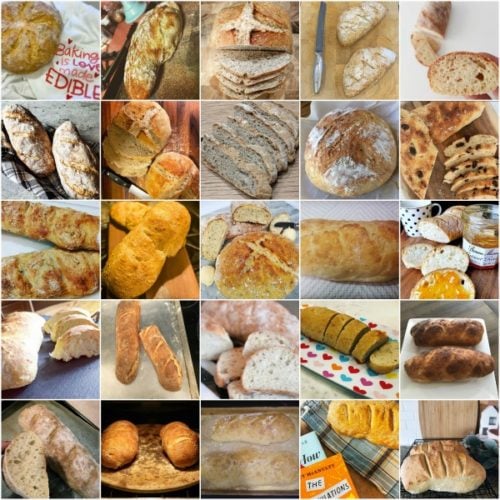
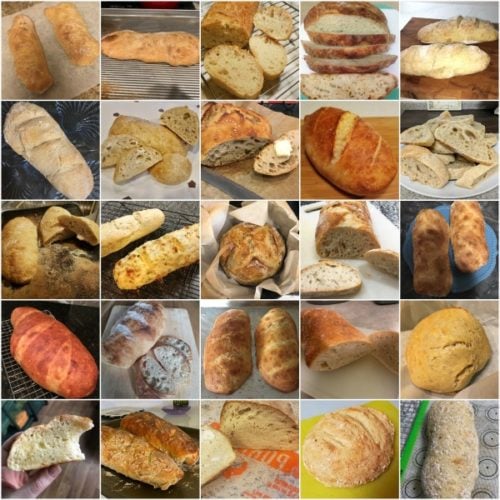
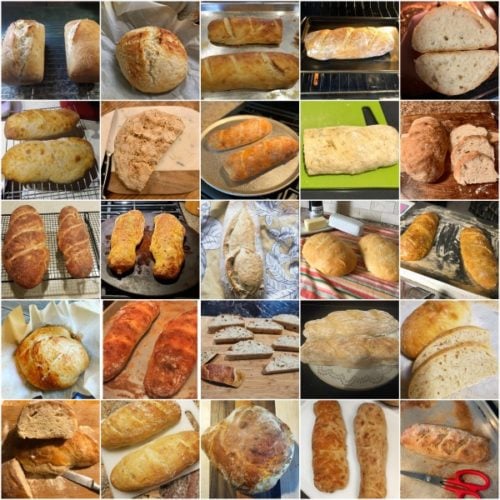
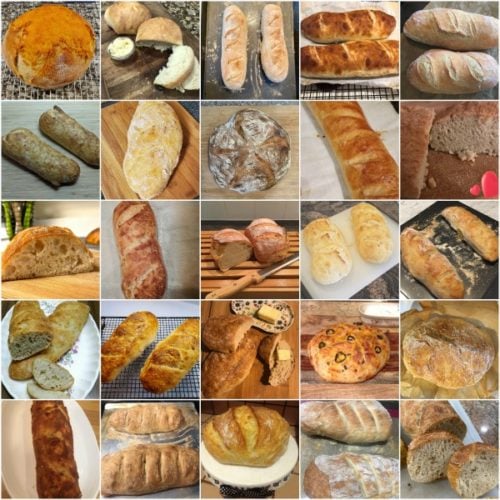

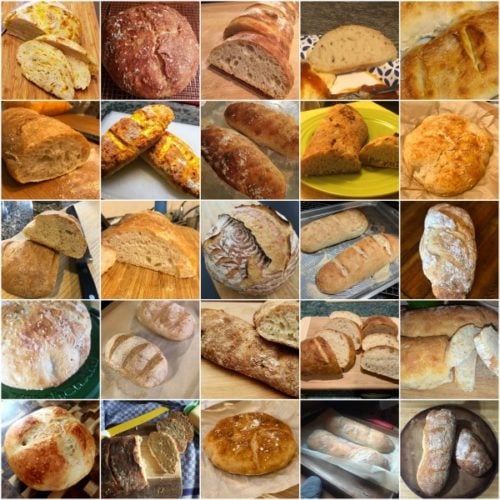
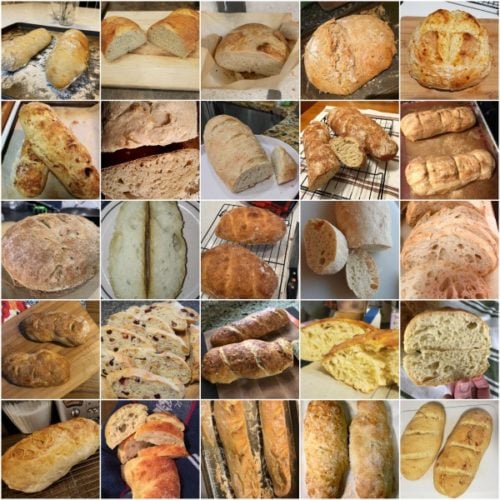
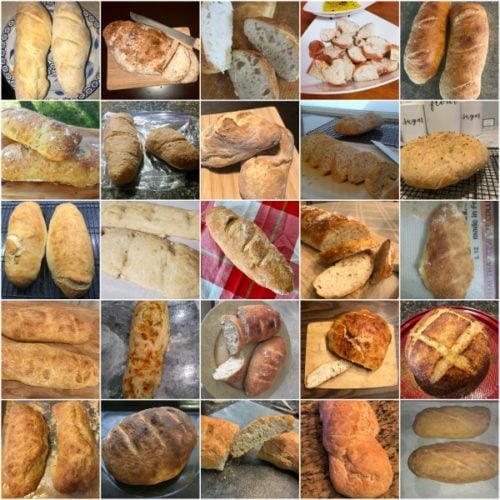

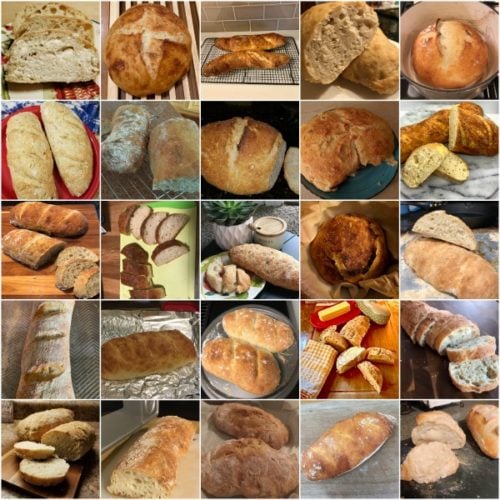
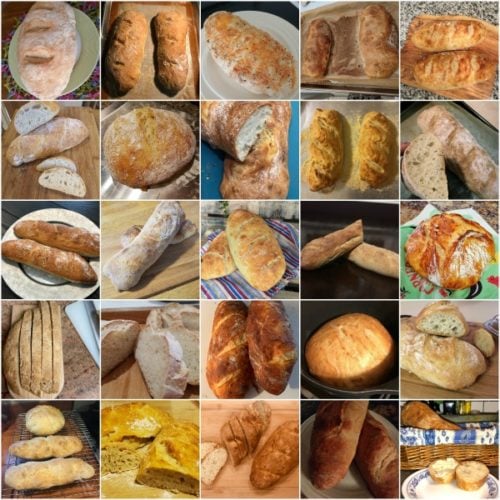
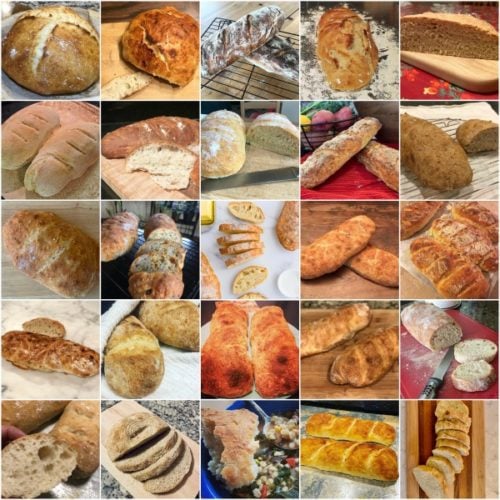
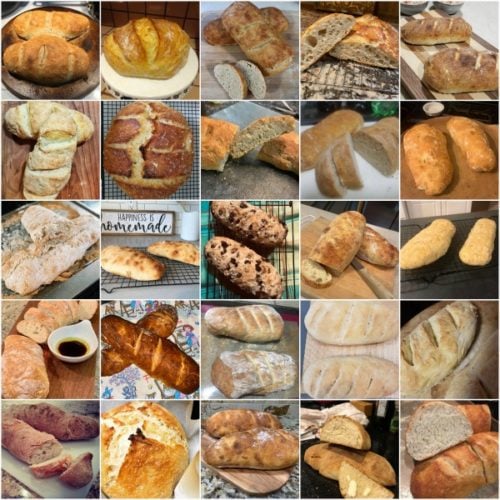
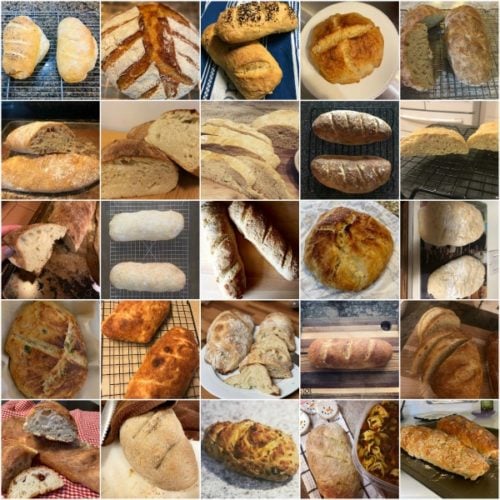
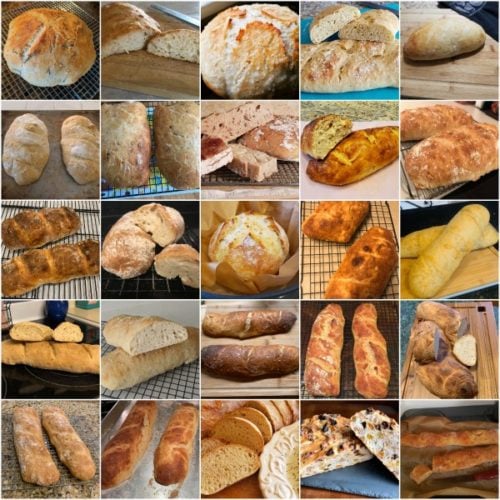
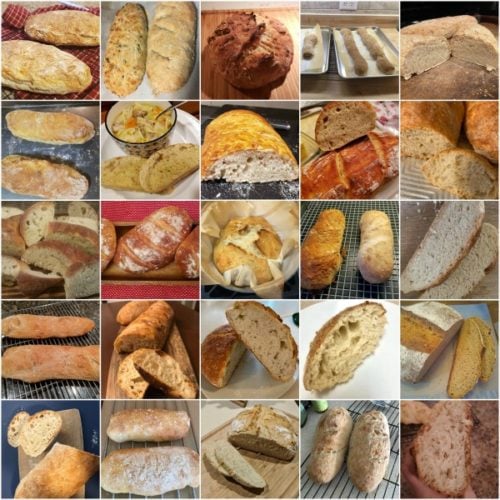
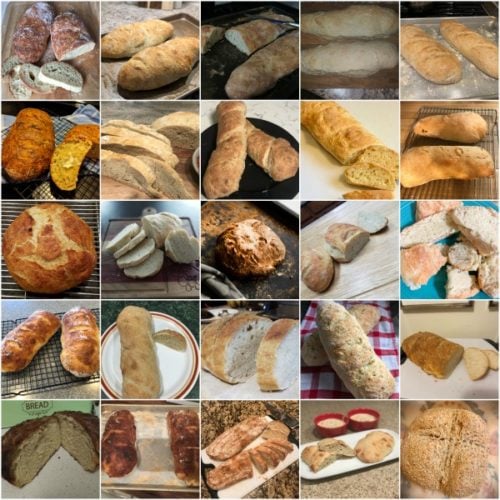
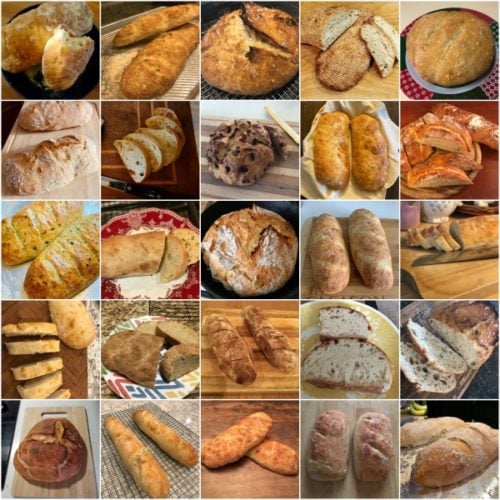
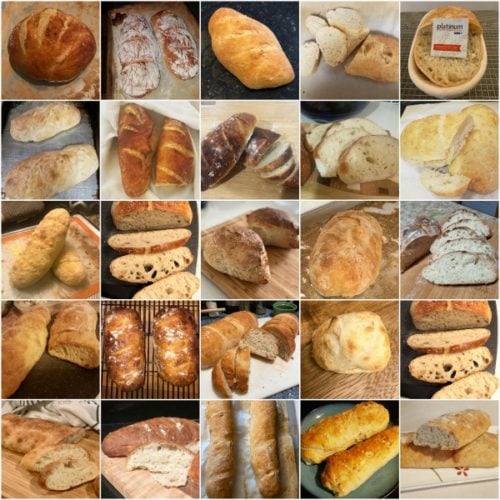
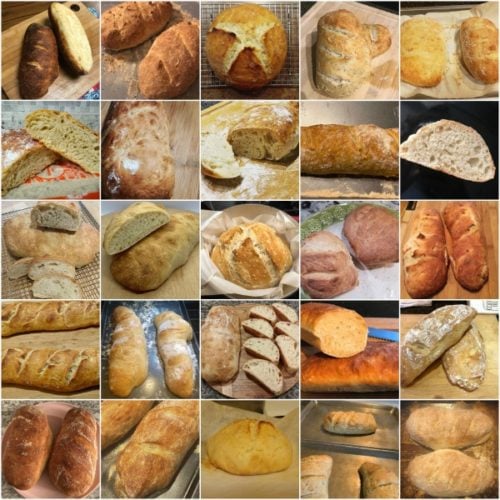
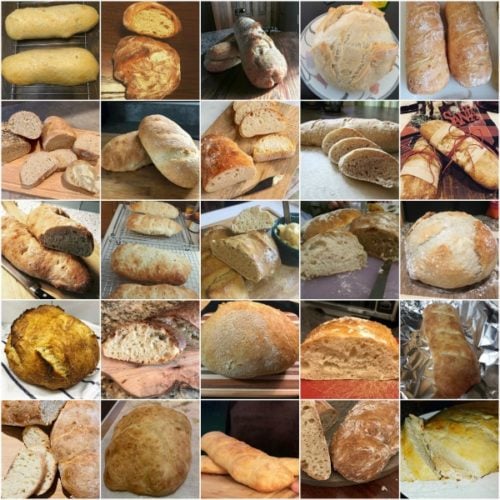
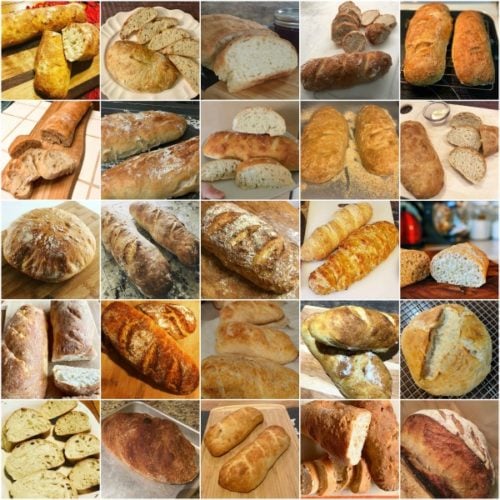
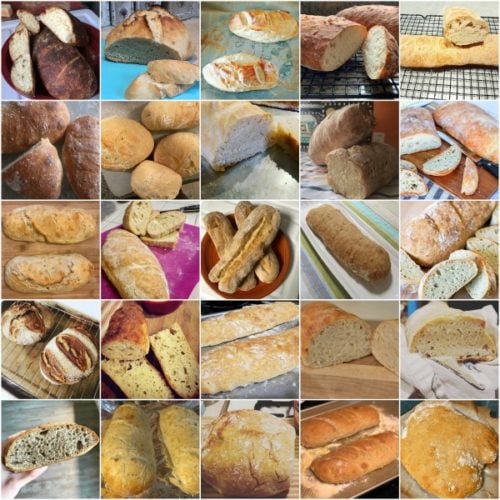
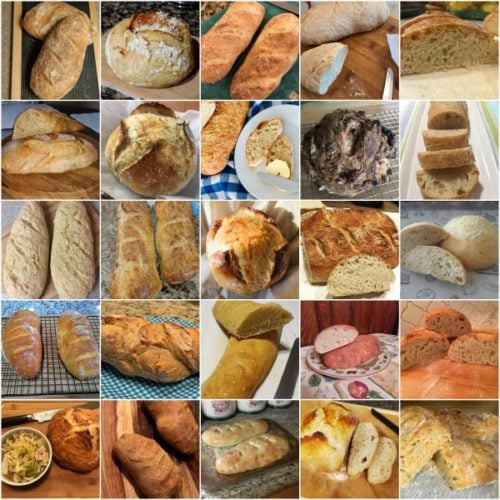
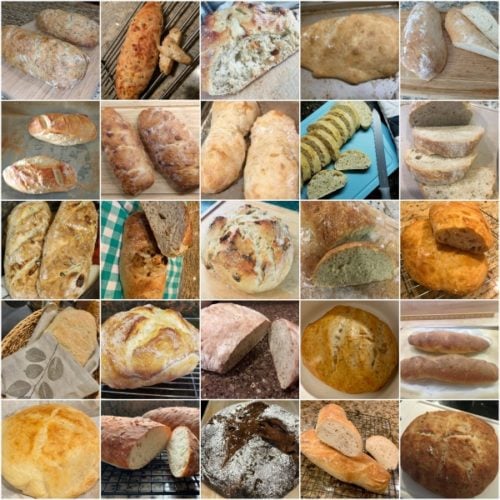
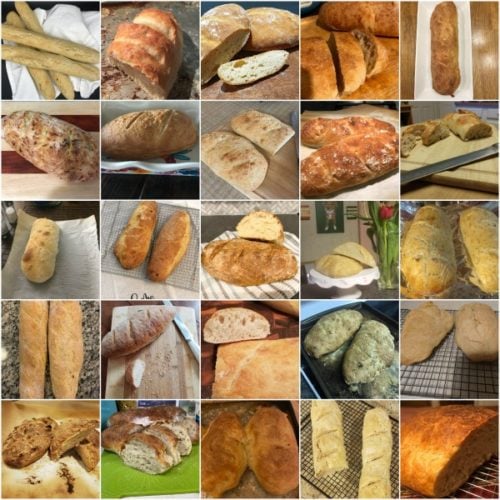
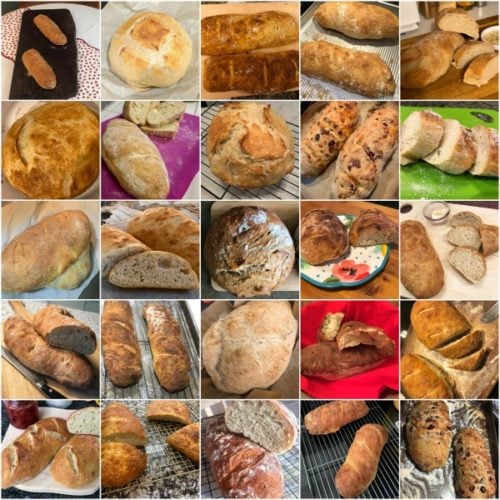
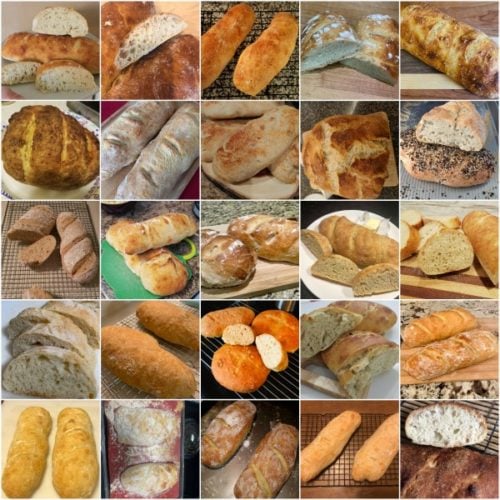
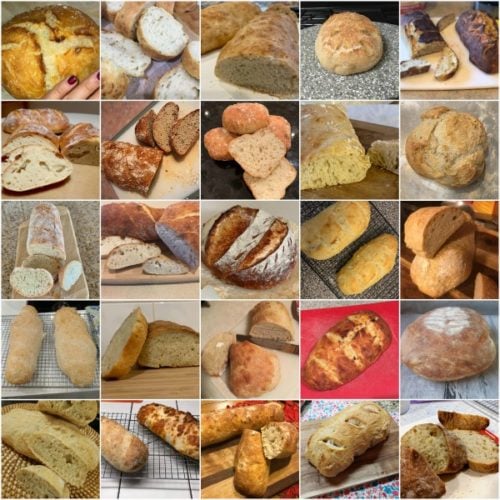
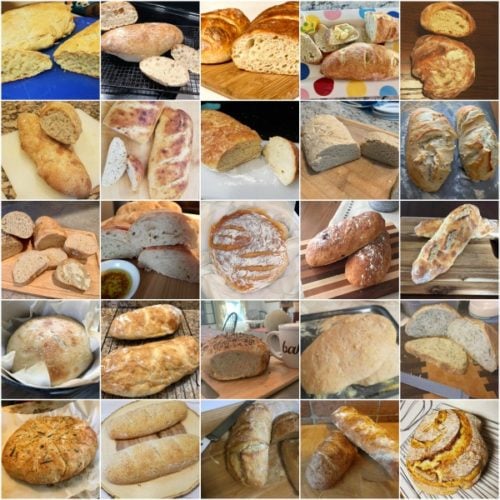
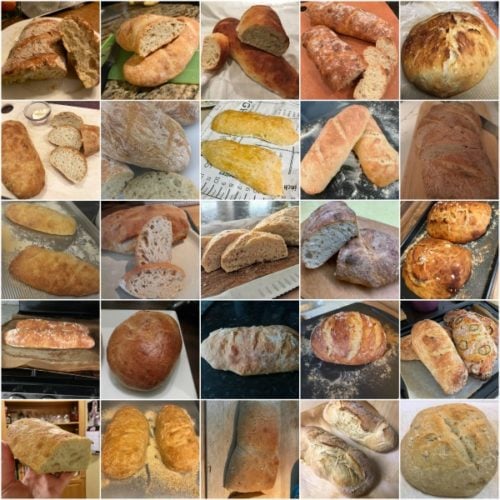
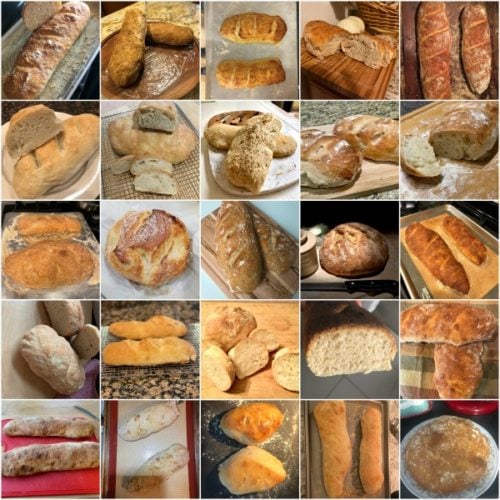
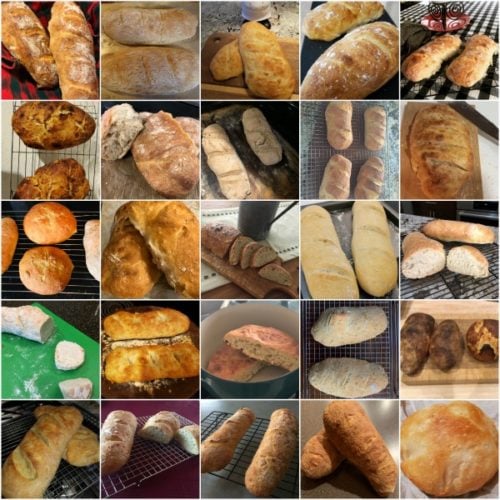
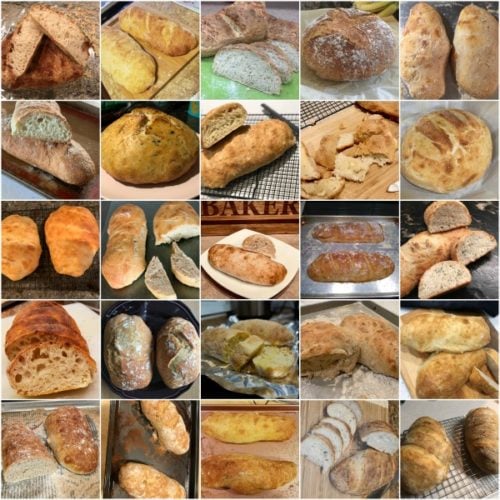
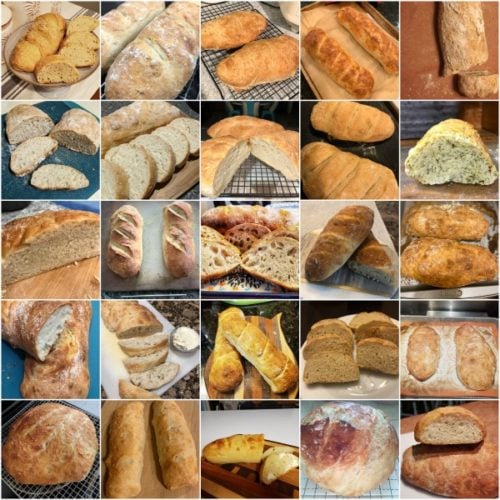
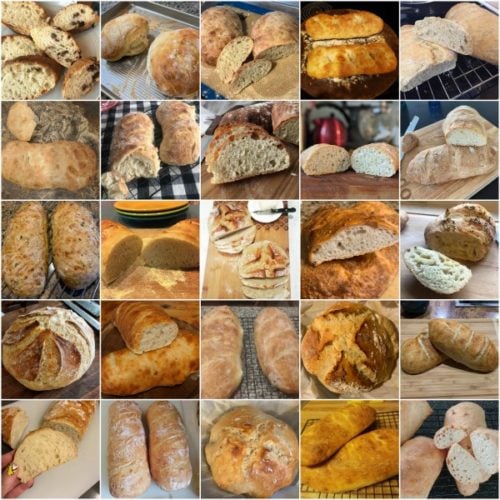



















First time making bread. May not have the holes yours has, maybe a little denser but tastes great and It will make wonderful toast. I think I will try Rosemary the next time. Thank you.
Just made this tonight. Did not wait 12 hours to bake although, I want to try that but I honestly don’t see how this could be any better. Wow! So delicious and easy!
This recipe is very good. Made it today and my bread turned out well. Went by the recipe except that when shaping the loaves I put olive oil on my hands to keep it from sticking I made a little mistake by not spraying my pan however I did put cornmeal in the pan. The bread came out of the pan ok but could have been easier. Lol
First time making bread and it turned out great! Ended up needing to add a little extra water due to the dry climate but otherwise perfect 🙂
Normally, I love garlic bread, but not as biscuits. If you leave out the garlic, they’re wonderful
Finally the perfect bread recipe! I love how Sally’s recipes give all the necessary details. She never leaves me wondering what to do!
This is my second time making this bread! So easy and so good!!
It was not my intention, but I ended up having to wait 3 days to bake this bread. I followed the instruction of the boiled water in a cast iron pan also! This was the best bread I’ve ever made! Will definitely try this again and add some herbs. Fabulous and very EASY recipe!
I love this recipe!! It’s so easy and tasty – this coming from someone who has always considered yeast my nemesis. Question – is it possible to use stone cut flour instead of bread flour? What would I need to adjust, if anything? Thanks!
Hi Paulette, we’re so glad you loved this recipe! We haven’t tried that substitution, but let us know if you do!
Can I use a kitchen aid mixer?
Hi Susan, We do not recommend a mixer for this particular dough– it’s very loose and sticky. A mixer wouldn’t be doing you (or the dough!) any favors. Luckily, it only requires a really quick mix with a wooden spoon or rubber spatula. Not much work involved!
I loved the ease of this recipe but mine was too dense after baking. What should I do different to get those soft holes inside?
Hi Carol! Make sure not to add too much flour to your dough (spoon and level or use a kitchen scale to measure). Too much flour could result in a dense bread. And also make sure to handle the dough with extra care to prevent popping the air bubbles before baking.
A first attempt with baking artisan bread. I added minced garlic and fresh rosemary. The bread was easy to make and very good. I’ll be making it again, probably adding cheese next time. Thank you for posting!
Best bread recipe ever! I tried it a couple of times and it was good, BUT when I used my Dutch oven to make one round loaf, it came out incredible! Also, I realized I had been adding a bit too much flour and kneeding it too much.
Made this recipe twice. First time was excellent. Second time the bottom crust was rock hard. What I did differently the second time: was using frozen dough, baked on cookie sheet dusted with cornmeal, temp as recipe specified at 475. First time around was fresh dough on parchment-covered sheet dusted with cornmeal, baked at 450 so the paper didn’t ignite. What do you think happened? PS I am a brand new baker so pretty clueless.
Hi Betty, Make sure not to add too much flour to your dough (spoon and level or use a kitchen scale to measure). Too much flour could result in a dense bread. And also make sure to handle the dough with extra care to prevent popping the air bubbles before baking.
Super easy. Very forgiving. Even with out of date yeast and using self rising flour.
I love this recipe. This and one other time make twice I have made bread. My husband said it was better than any store bought and for me not to lose the recipe.
This recipe sucks. I’ve made many kinds of bread and this recipe is by far the worst
Hi,
This recipe calls for way too much water, I tried it with AP flour and bread flour, with cups and with the kitchen counter and everytime I had to add more flour. I really don’t understand how so many people said it came out perfect without mentioning this.
I have made this recipe at least 2 dozen times and never had this issue. Could be your location or maybe your measuring cup?
Hello, this is the 2nd time I have made this recipe. I use a digital scale and measure everything. The dough comes out very wet. Unlike your video. I added maybe a quarter to half cup more flour. By the time I incorporate the extra four. The dough becomes very elastic. What am I doing wrong?
Hi Mark, This is a very wet dough, but there are a lot of variables that go into the consistency of dough, even down to the weather and humidity in the air. There’s nothing wrong with adding just a little more flour to bring the dough into a slightly less sticky consistency.
So delicious and unbelievably easy! If you’ve been nervous to try bread, this is the recipe to start with. Made it for the third time today and got told my friends thought it was store bought. It was that good.
Since you’re calling for coarse salt I’m wondering if kosher salt would work?
Hi Peggy, kosher salt works great here!
This recipe creates a VERY wet sticky dough that is impossible to shape and work with. I’d recommend using less water.
Hi Elliot, thanks so much for giving this recipe a try. There are a lot of variables that can go into the consistency of dough, down to even the weather or humidity. If you decide to try this recipe again, feel free to add additional flour a tablespoon at a time until the dough comes to a workable consistency. Thanks again!
This is a great recipe. Two questions. If I put it in the fridge overnight, do I punch the dough down or reshape it after it’s risen on the counter or just put it in the fridge as is?
Second – I’d like to double the recipe and cook in my Dutch oven but I don’t think a double batch will fit. Is it OK to leave half the dough out at room temperature while I cook the first batch? Will it rise too much? Should it go in the fridge?
Hi Edimuz, no need to punch down the dough before placing in the refrigerator. For best results, we recommend making two separate batches rather than doubling. However, while the first batch is baking, you could allow the second loaf to have its 45 minutes rest at room temperature (in step 4). Hope this helps!
I love the idea of making rolls right before I serve lunch sandwiches to guests. Can this recipe be used for rolls? Should there be some kind of wash on them (i.e. for sesame seeds, etc)
You can use this dough to make smaller rolls, yes. Bake time will depend on the size you make them. Bake until the crust is golden brown and when you tap the loaves– they will sound hollow when done. You could certainly do a simple egg wash on top to add sesame seeds or other toppings. Let us know how it goes!
I’ve made this recipe a few times and really enjoyed it. I’m wanting to make the recipe with add ins but I was wondering if it would make a difference to wait a few hours for the bread to double in size, then fold in the add ins and either leave it on the counter for another few hours before placing in the fridge or placing in the fridge from there? Would it improve the loaf or not make that much of a difference?
Hi Audrey, we haven’t tried that as we typically incorporate the add-ins before the dough has its rest on the counter (and before going into the refrigerator). Let us know if you decide to give this a try!
Made this today and it was delicious!!
I love this recipe but don’t seem to get the big air holes. I priced on the counter and refrigerated until the next evening. Proofed on counter for an hour. It was dense with only a few air holes. What am I doing wrong?
Hi Jules, Every loaf will turn out a bit differently. Make sure to handle the dough very carefully to prevent compressing the air bubbles. So glad you enjoyed it!
Another beautiful recipe! Have made it many times and it turns out well each time, although slightly different, each time… What makes this dough to be sooo sticky? Could I bake the loafs in a baguette pan? Thank you for your time.
Hi Ruth, we’re so glad you’re loving this bread! There are many variables that can go into the consistency of bread dough, down to even the weather and humidity. If you find the dough is too sticky to work with, you can add more flour a tablespoon at a time until it comes to a workable consistency. We haven’t personally tried baguette pans, although some readers have reported success doing so. Let us know if you give it a try!
Can I mix buckwheat honey in this recipe
Hi Laurie, we haven’t tested this recipe with honey, but some readers have reported back that they’ve had success with adding it. We also have a honey oat bread recipe you might enjoy. Happy baking!
I have tried to bake bread before but it never came out right I have tried this receipe once before and my wife and I couldn’t stop eating this toasted with butter, It had a great taste not like the bland store bought bread . thank you for this simple recipe.